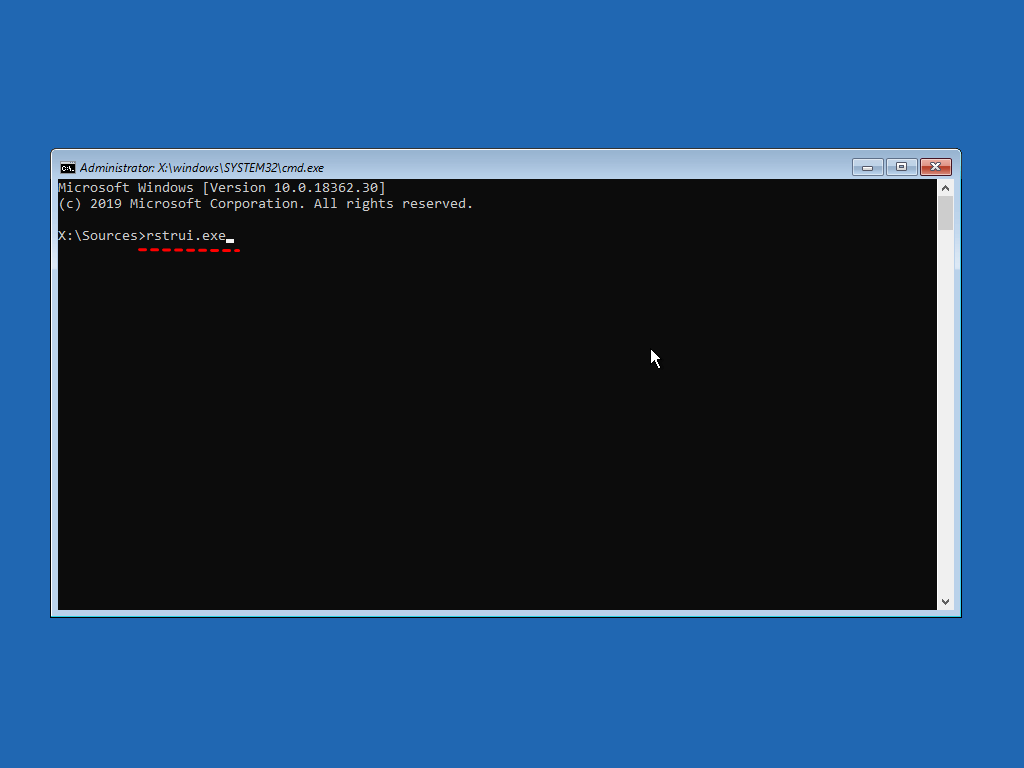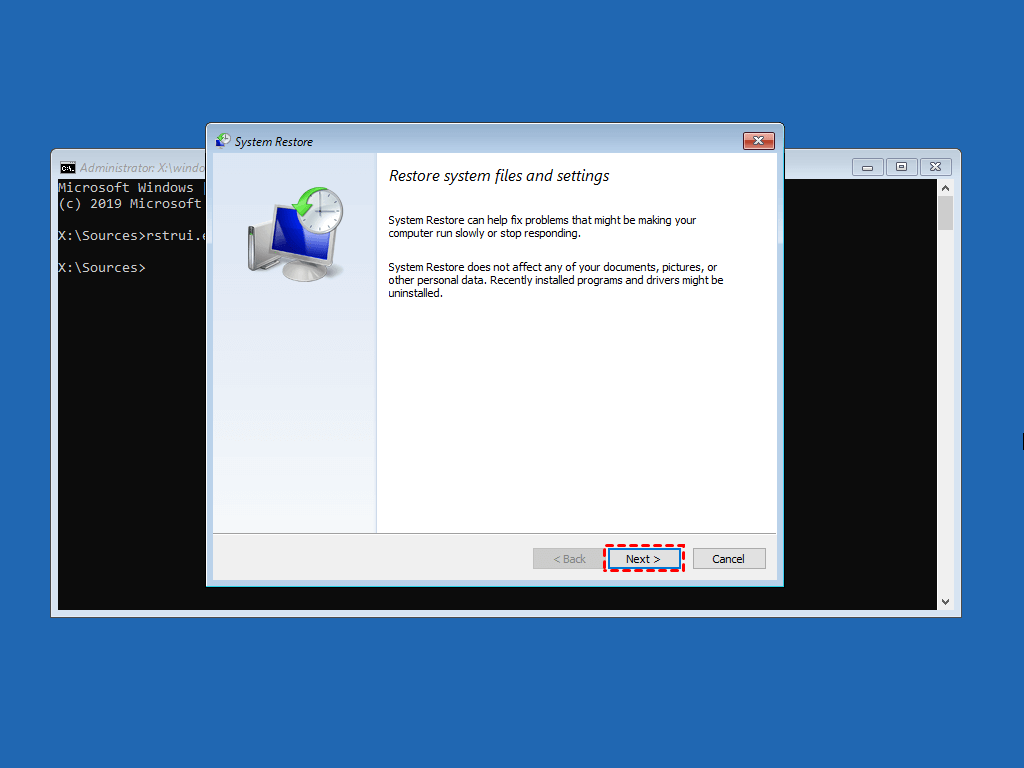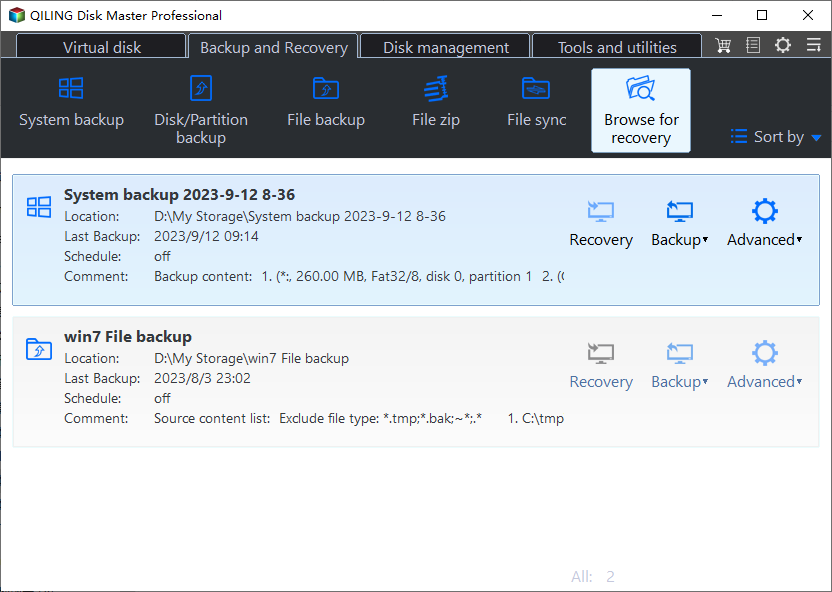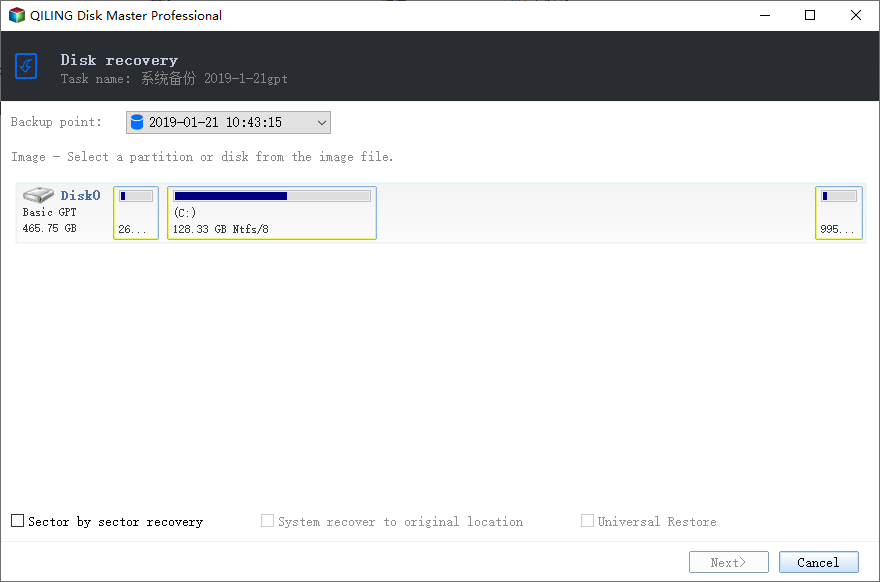How to System Restore Windows 10/11 from Command Prompt
- How Do I Run System Restore from Command Prompt
- Method 1. Run System Restore in Safe Mode with Command Prompt
- Method 2. System Restore Windows 10/11 from CMD in WinRE
- Easier Alternative to Restore System in Windows 10/11
- How to perform system restore from command prompt via Qiling Disk Master
- Easier way to restore system with Qiling Disk Master GUI
- Conclusion
How Do I Run System Restore from Command Prompt
System Restore is a useful tool to help you restore operating system to a previous state if some errors occur. But when the problem is so bad that you cannot boot the computer properly, it‘s impossible to access System Restore inside of the system. In this case, you will need to run System Restore from Command Prompt in Windows 10/11.
To do so, you may start your computer in Safe Mode with Command Prompt, or access the Command Prompt option in Windows recovery environment using a bootable disk.
Here are 2 methods to system restore Windows 10/11 from Command Prompt, and an easier alternative that can backup and restore your operating system flexibly.
Content of this article:
- Method 1. Run System Restore in Safe Mode with Command Prompt
- Method 2. System Restore Windows 10/11 from CMD in WinRE
- Easier Alternative to Restore System in Windows 10/11
Method 1. Run System Restore in Safe Mode with Command Prompt
As above mentioned, if you are unable to access your Windows system normally due to some error (driver installation, Windows update) or virus infection. You can try to restore your system settings to an earlier date.
Please note that the restore operation cannot be undone if you perform system restore in safe mode. If you want to undo changes made by this operation, you could choose to use the installation disc that comes along with your computer.
If you don't have any kind of this disc, it's a wise choice to create Windows 10/11 recovery drive or installation disc on another working computer with the same hardware as this computer.
Next, you will learn how to launch the System Restore tool from Safe Mode with Command Prompt in Windows 10/11. Also, it works in the the lastest Windows 11 and previous version of Windows, such as, Windows 7/8/8.1.
1. Press and hold the Shift key while you select Power > Restart from the Start menu.
2. After your PC restarts to the Choose an option screen, select Troubleshoot > Advanced options > Startup Settings > Restart.
Note: If your computer can boot normally, press Win + R and type cmd in the Run box.
3. Select Enable Safe Mode with Command Prompt via number key 6 or function key F6.
3. Sign in using an administrator account if needed. Once the command prompt is showing, type the command: rstrui.exe, then press Enter.
Note: The rstrui.exe is located in C:\Windows\System32 folder by default. Thus, if you find your computer has more than one rstrui.exe file or the file name is not exactly the same, for example, rstrul.exe, restrui.exe or rstri.exe, please treat it with caution. These will happen if the computer has a virus.
4. Here you will come to System Restore wizard. You can either use recommended restore point or choose a restore point. Then click Next. Follow the instruction to complete system restore.
Method 2. System Restore Windows 10/11 from CMD in WinRE
1. Create an installation disc with media creation tool for Windows 10/11 if you don't have. Also, if you don't have any CD/DVD, you can choose to create a recovery disk in Windows 10/11 with built-in tool Recovery Drive.
2. Insert the installation disc into your computer, start your computer and press the specific key to access BIOS, such as, ESC, F2, etc. Then, go to Boot menu and move the CD-ROM Drive to first option via “+”, then press F10 or Enter to exit this window.
3. Click Next > Repair your computer > Troubleshoot > Advanced options > Command Prompt.
Then type rstrui.exe and hit Enter to start the System Restore Wizard. After that, you just need to follow the on-screen instructions to restore your computer to previous date.
However, this method can be tricky sometimes. You may get error message, such as, System Restore did not complete successfully, Windows cannot find a system image on this computer, etc. Besides, you may find that there is no system restore point when you open this wizard. So, you’d better run a guaranteed software to restore your system.
Easier Alternative to Restore System in Windows 10/11
If system restore not working in safe mode/using installation disc, or if the restoration simply failed, there is another way to help you restore Windows system simply and securely.
Qiling Disk Master Professional is one of the best backup and restore software. With it, you can restore system, partition, hard drive to previous date. With its Universal Restore feature, you can even restore system to a dissimilar hardware.
🔹It’s a complete and powerful backup software supporting Windows 11/10/8.1/8/7/XP/Vista.
🔹 Not only operating system, it can also be used to restore partition, disk, or individual files & folders.
🔹You can operate it either from Command Prompt or in an easy-to-use graphic user interface.
🔹In case the computer not boot, you can create a bootable media to restore system in WinPE.
Please download Qiling Disk Master Professional at first and follow the guide to run Windows 10 system restore using command prompt or an intuitive GUI. And it also works for Winodows 11 and previous system.
Before running system restore using command prompt in Windows 10/11, you need to do some preparations.
◾ First of all, you should have a system backup created by Qiling Disk Master. Because the restore operation is only based on backup image created by Qiling Disk Master. If you don't have a system backup with Qiling Disk Master, you can create one now based on another working machine.
◾ If you cannot boot computer, create a bootable media with Qiling Disk Master.
◾ To make sure the restore process is smooth, you can use Check Image utilities to check if system image backup is intact and without error.
How to perform system restore from command prompt via Qiling Disk Master
1. Boot machine from bootable media and it will bring you to the main interface of Qiling Disk Master. Insert the drive containing image into your computer and make sure it can be recoginzed.
2. Open command line under Tools tab. Type the following command and go to Qiling Disk Master installation directory. For example: cd C:\Program Files (x86)\Qiling Disk Master.
Notes:
❤ The path cd C:\Program Files (x86)\Qiling Disk Master is just an example, please check the installation directory of this software and replace it with your own.
❤ If you run this command under Windows PE environment, the drive letters might change.
3. Run the following command to restore image on the current computer:
For example: To restore the system backup saved in J:\systembackup1 to disk 1. You should type the command:
If you need to restore to another computer, Qiling Disk Master Universal Restore feature can make this very easy. For example: Run system restore in the image named "systembackup1.fvd" to the partition 0 on disk 0 and perform a universal restore.
Note: there are some required parameters in Qiling Disk Master.
{/r}: restore the backup of system, disk, partition or dynamic volume.
{/t} {system | disk | part}: specify restore type.
{/s}{D:\system backup\systembackup1.fvd}: specify the path of the image file.
[/x]: specify universal restore to restore system to dissimilar hardware. It has to be used with "/t system" and "/t disk".
Easier way to restore system with Qiling Disk Master GUI
If you are not fond of using Windows 10/11 system restore command line, you can also choose to restore easily from Qiling GUI in the main interface of Qiling Disk Master. It only takes you 4 steps.
1. Connect the device containing system image backup to your computer and start it via bootable media.
2. In the main interface of Qiling Disk Master, click Restore and Select Image File to choose a system image backup from the connected device.
3. Tick Restore this system backup and click Next.
4. Choose a destination disk if you tick Restore system to other location and click Next. Then, confirm the operation summary and click Proceed if there is no problem.
Note: If the computer you restore has different hardware, please remember to tick "Universal Restore". This feature can ensure secure boot after restoration.
Besides backup and restore, Qiling Disk Master is also an excellent disk clone software. With it, you can make an exact copy of hard drive. If you need to keep OS on SSD, you can use this software to clone OS to SSD. Besides Windows 10, this tool can be used in the latest Windows 11 and previous Windows 7/8/8.1/XP/Visa.
Conclusion
To make a conclusion, system restore Windows 10/11 with command prompt may be helpful to revert your system to a good state, but System Restore is not as almighty as you think. For example: system restore does not restore your personal files.
If you have a system backup created by Qiling Disk Master, you can run system restore in Windows 10/11 using command prompt. Also, you can choose to restore from Qiling GUI. Also, it's capable of creating disk image, backup files to external hard drive in Windows 10, backup EFI system partition, etc.
If you want to protect unlimited computers within your company, you can pick Qiling Disk Master Technician. With the inbuilt Qiling Image Deploy tool, you are also allowed to deploy/restore system image file on server-side computer to multiple client-side computers over network.
Related Articles
- How to Fix Backup and Restore Windows 7 Not Working
- System Restore Did Not Complete Successfully - Fixed
- How to Repair Windows Server 2008 R2 Using Command Prompt
- How to Make Lenovo Boot from USB in Windows 10
Create bootable USB drive with the best free Windows 10 media creation tool - Qiling Disk Master and then let Lenovo boot from USB in Windows 10 to troubleshoot problems.







